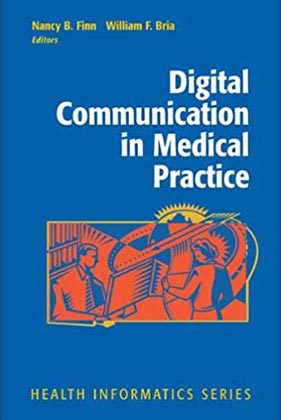Service Area : USA
Digital Communication in Medical Practice

Digital Communication in Medical Practice by Nancy B. Finn, with coauthor William F. Bria, MD, CMIO, Shriners Hospitals for Children, published by Springer Verlag in May 2009, is targeted to a practicing clinician.
This book helps providers understand how digital technologies, including the Internet, email, smartphones, and videos, enable more efficient, quality, and continuous patient care. It addresses the frustrating issue of how too little time, too many patients, and information overload hamper a clinician’s ability to provide the best possible care for each patient.
Advancing Technology in Healthcare
Using case studies, statistics, facts, and sound arguments, Digital Communication in Medical Practice makes a strong case for why clinicians and their patients will benefit from implementing digital health records and engaging with patients using email and patient portals.
Nancy illustrates how telemedicine, Computer Physician Order Entry (CPOE), e-prescribing, and collaborative doctor/pharmacist teams provide an answer to the alarming rate of medication errors. She also emphasizes the importance of evidence-based medicine and addresses legislative initiatives that protect doctors and patients from unauthorized access to medical records. The complex challenges of cost, quality, safety, and access to healthcare are well–analyzed in this insightful, practical, and timely book.
Digital Communication in Medical Practice

Digital Communication in Medical Practice with co-author William F. Bria, MD, CMIO, Shriners Hospitals for Children, published by Springer Verlag in May 2009, is targeted to a practicing clinician. This book helps providers understand how digital technologies, including the internet, email, smartphones, and video, can enable more efficient, better quality, continuous care for patients. It addresses the frustrating issue of how too little time, too many patients, and information overload hampers a clinician’s ability to provide the best possible care for each patient.
Using case studies, statistics, facts, and sound arguments, this book makes a strong case for why clinicians and their patients will benefit by implementing digital health records and engaging with patients using email and patient portals. Finn also illustrates how telemedicine, CPOE (Computerized Physician Order Entry), e-prescribing, and collaborative doctor/pharmacist teams will provide an answer to the alarming rate of medication errors. She also emphasizes the importance of evidence-based medicine and addresses legislative initiatives that protect doctors and patients from unauthorized access to medical records. The complex challenges of cost, quality, safety, and access to healthcare are well analyzed in this insightful, practical, timely book.
